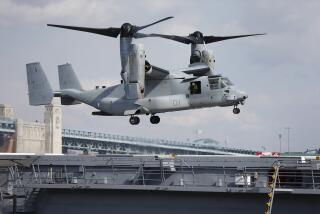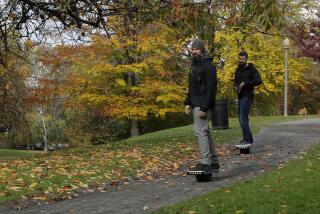Army to Make Safety Check of All Night-Vision Goggles
- Share via
WASHINGTON — The Army announced Monday that it will inspect all of its night-vision goggles to determine whether they are safe for night flying.
The decision to make the one-time evaluation, involving about 12,700 of the devices, was made in the wake of dozens of fatal nighttime helicopter crashes in which pilots were using the goggles, which originally were designed for use by tank and truck drivers.
However, the Army continued to insist that no helicopter accidents had been directly caused by the goggles and said that it will continue to fly high-speed, low-altitude night missions using the devices while the inspection is under way.
Hearings in House
Meanwhile, a House subcommittee opens hearings today on the night-vision devices amid calls by some lawmakers to suspend their use until their safety can be assured.
“Given the continuing wreckage and loss of life, it seems to be a reasonable request to temporarily suspend missions requiring night-vision goggles,” Rep. Frank McCloskey (D-Ind.) said.
In the last 11 years, flight crews equipped with goggles have been involved in 49 serious accidents, the most recent occurring on March 12, when a CH-3E helicopter assigned to the Air Force Reserve crashed near Tucson, Ariz., killing 15 servicemen.
Congressional investigators have alleged that 137 Army, Marine Corps and Air Force aviation deaths over the last decade have been caused by use or misuse of the goggles.
Army Not Blaming Goggles
But Lt. Col. Greg Rixon, an Army spokesman, said: “We have not attributed any aviation accidents directly to night-vision goggle use. There are three things we look at after a crash: pilot error, mechanical failure and the environment. We have not found any cases where the absolute reason for the crash was a failure in the night vision system.”
Rixon said that many of the accidents blamed on the goggles were in fact caused by pilots using them without sufficient moonlight to enable the devices to work properly. If a pilot violates Army standards for ambient light, the crash is blamed on pilot error, not on the goggles, he said.
Complaints of Distortion
The spokesman said that two models of the goggles had been withdrawn from service in aviation last year because of distortion in their viewing systems. Some aviators have also complained about distortion in two newer models.
Over the next two weeks, all four models will be inspected to check for distortion, which is caused by a defect in the goggles’ light-amplifying tubes.
“Every goggle that can be used for flight is going to be evaluated,” Rixon said. “If there are no problems, the goggle is cleared for use. If there is a problem, it takes about 45 minutes to change the tube.”
$5,000 Replacement Tubes
The spokesman said that the cost of replacing the goggle tubes ranges from $1,100 to $5,000, depending on the model.
The Army has no plans to suspend use of the goggles in night flying, Rixon said. In answering congressional critics, Rixon said: “Aviation is inherently a dangerous business. Airplanes are hard to work and hard to maintain, but they give us capabilities we wouldn’t otherwise have.
“You can keep peeling the safety onion until you get to the point where you don’t do anything. You have to weigh risk against gain,” he added.
More to Read
Sign up for Essential California
The most important California stories and recommendations in your inbox every morning.
You may occasionally receive promotional content from the Los Angeles Times.













